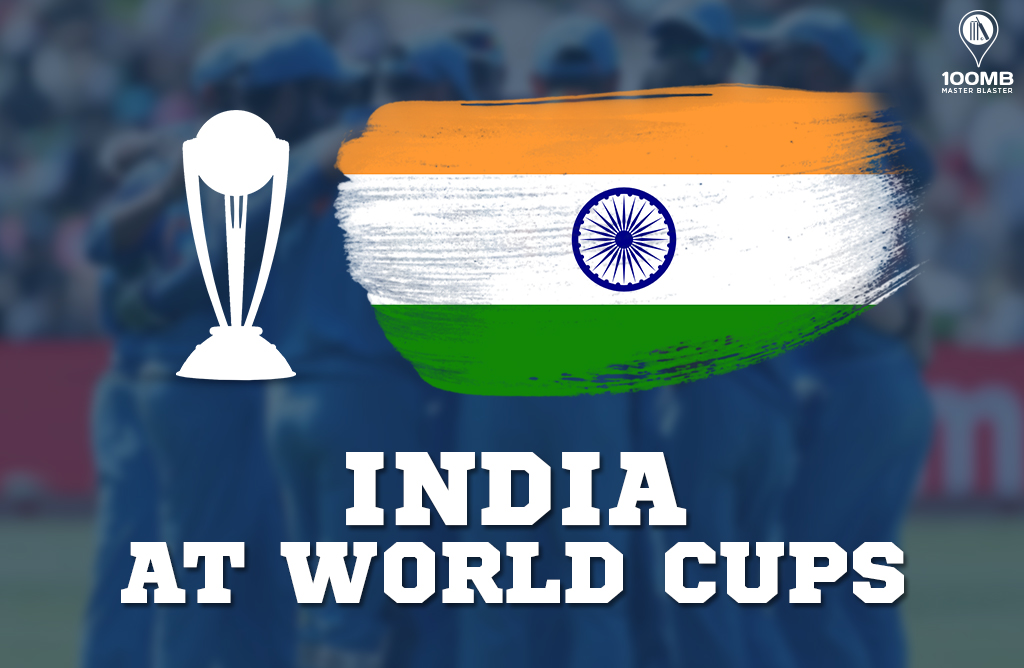India at World Cups – Forever Favourites

India have been one of the mainstays at the World Cup, having participated in all the 11 editions so far. The journey through the 11 World Cups has seen India become the undisputed powerhouse of the game, with the 1983 World Cup sparking a national revolution which had a major impact internationally. As the Virat Kohli leads India in its 12th World Cup, we take a look back at the journey which has had its fair share of ups and downs.
Team Record:
Played – 75, Won – 46, Lost – 27, Tie – 1, No Result – 1
Notable Performances:
Winners – 1983, 2011
Finalists – 2003
Semi-finals – 1987, 1996, 2015
Most runs: Sachin Tendulkar (2278 runs in 45 matches)
Most wickets: Zaheer Khan (44 wickets in 23 matches)
History:
In the maiden edition of the tournament in England, India were relative novices under the leadership of S Venkataraghavan, having played their first ODI only a year back. No one gave them much of a chance and India disappointed, bowing out of the group stages with one win and two losses. The win came against minnows East Africa. The 1975 edition is still notorious for Sunil Gavaskar’s 36 off 174 balls when the team were chasing a big target of 335 in 60 overs against England for a win.
The 1979 edition was no different, as India were again poor, which led to some radical changes in the Indian set-up in the aftermath. The squad was again led by Venkataraghavan for the tournament in England which had the same format as the 1975 edition. It was a chastening experience for the squad as they lost all the three matches against West Indies, New Zealand and Sri Lanka and returned home without a win. This created a stage for some bold decisions to be made which would change the course of the game in the country forever.
The start of a revolution:
Heading into the 1983 edition of the tournament in England, India were the firm underdogs due to their prior performances in the 1975 and 79. But in Kapil Dev, they had a charismatic and a bold leader with a squad which were willing to follow him into the field of battle. India started the campaign by shocking the world, inflicting a 34-run loss on the favourites West Indies. This set the tone for the rest of the campaign as even back-to-back defeats against Australia and the West Indies could not derail the team. In two must-win matches against Zimbabwe and Australia, many performers rose like a phoenix to make sure that India reached the semis. Kapil Dev’s innings of 175 against Zimbabwe was in particular, notable as India were struggling for 17/5 when he came out to bat. India then facing the hosts England in the semis, caused another major upset, beating them by 6-wickets to register a relatively comfortable victory.
The tournament ended just as it started for India as they inflicted a major defeat on the two-times defending champions West Indies. When the Windies were set a target of 184 for a win, nobody gave the Indians even a slight chance. But a heroic performance from their innocuous yet accurate medium pacers meant that India were able to bowl out the Caribbean outfit for a meagre total of 140. As Kapil Dev lifted the Prudential Cup on the balcony of Lord’s, cricket in India would change forever, with that moment inspiring generations to come.
The favourites disappoint:
The 1987 edition of the tournament was the first one to be held outside England, with India on the virtue of being the defending champions co-hosting the tournament with Pakistan. Billed as the pre-tournament favourites, India comfortably reached the semi-finals with their only loss in the group stages coming against Australia in the opener in Chennai. Facing England in Mumbai in the semis, India disappointed with the quality of opener Graham Gooch proving too much for the hosts to handle. His century inflicted a 35-run loss on India, breaking the hearts of an entire nation.
Under Azhar’s leadership:
Elegant batsman Mohammad Azharuddin was handed the command of the Indian side for their next three World Cup campaigns. It was a mixed bag for the fortunes of the Indian team as despite having some quality players in their ranks, could not mount a serious challenge. In 1992, India failed to qualify for the semi-finals for the first time since 1987, finishing in 7th place in the Round Robin with only 2 wins and 5 losses, while one game was abandoned due to rain. Co-hosting the tournament in 1996, India reached the semi-finals, where they faced off against Sri Lanka. The match in Kolkata was abandoned due to crowd trouble after Sachin’s wicket led to a massive Indian batting collapse. India again disappointed in the 1999 edition in England, bowing out of the Super Six, with four wins and four losses in the tournament. This brought about an end to the Azhar years, with a young and charismatic leader then emerging to re-ignite Indian cricket.
A new crop emerges:
Under Sourav Ganguly’s leadership, Indian cricket again found its footing. The pinnacle of it was the 2003 World Cup where India reached the finals. During the tournament, there were some memorable victories against England and Pakistan, as India faced off against defending champions Australia in Johannesburg. Though India were comprehensively beaten by 125 runs in the final, the tournament had various positives. Many new talents like Virender Sehwag, Zaheer Khan, Yuvraj Singh, Harbhajan Singh and Mohammad Kaif had emerged, who would serve Indian cricket brilliantly for years to come.
The darkest of timelines:
Heading into the 2007 World Cup, India were one of the favourites to win the tournament with the quality and experience which they had in their squad. But the period was marred by in-fighting and politics within the ranks with Greg Chappell at the helm as the coach. India bowed out of the group stages itself in West Indies, losing matches against Sri Lanka and Bangladesh, with the latter being a major upset. Their only victory came against minnows Bermuda. The performance angered people back in the country who vented out their frustrations on the team when they arrived back home.
The long wait ends:
Co-hosting the 2011 edition along with Bangladesh and Sri Lanka, India were instilled as the heavy favourites prior to the tournament. They had a very strong batting core, along with some canny operators with the ball. MS Dhoni had also emerged as one of the finest leaders in the game. India lived up to all the hype, clinching some memorable victories to seal a World Cup crown after 28 long years. They had to face some tough opposition. They first beat Australia in the quarter-finals, followed by an emotional victory over Pakistan in the semis.
In the final against Sri Lanka, the Indians were set up a tough target of 275 to chase courtesy of a brilliant century by Mahela Jayawardene. Malinga’s blistering opening spell with the ball then left Indian reeling, but Gautam Gambhir and skipper Mahendra Singh Dhoni with heroic knocks sealed a memorable victory for India at the Wankhede Stadium in Mumbai. The six with which Dhoni sealed the win for India, causing a wave of euphoria is an image which has become immortal in the minds of many. This was also the final tournament for the legendary Sachin Tendulkar, who was carried on the shoulders of his teammates for a victory lap.
A new generation takes over:
The 2015 World Cup in Australia and New Zealand saw a host of new faces in the Indian set-up. Many of the stalwarts of the 2011 victory were phased out of the squad and new talents had emerged, who have become the cornerstone of Indian cricket right now. Though not the favourites, India did perform admirably well, reaching the semis where they were eventually beaten by the champions Australia by 95 runs in Sydney. Many new players like Bhuvneshwar Kumar, Mohammed Shami, Umesh Yadav and Shikhar Dhawan emerged as key performers for India. Rohit Sharma and Virat Kohli established themselves as two of the finest ODI batters in the world.
With the 2019 World Cup on the horizon, many of the same players will have a big role to play as India aim to clinch their third World Cup triumph.
